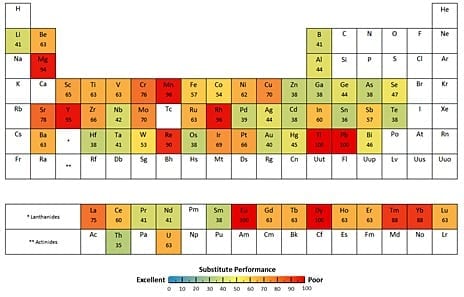
In a new paper, a team of Yale researchers assesses the “criticality” of all 62 metals on the Periodic Table of Elements, providing key insights into which materials might become more difficult to find in the coming decades, which ones will exact the highest environmental costs — and which ones simply cannot be replaced as components of vital technologies.
During the past decade, sporadic shortages of metals needed to create a wide range of high-tech products have inspired attempts to quantify the criticality of these materials, defined by the relative importance of the elements’ uses and their global availability.
Many of the metals traditionally used in manufacturing, such as zinc, copper, and aluminum, show no signs of vulnerability. But other metals critical in the production of newer technologies — like smartphones, infrared optics, and medical imaging — may be harder to obtain in coming decades, said Thomas Graedel, the Clifton R. Musser Professor of Industrial Ecology at the Yale School of Forestry & Environmental Studies and lead author of the paper.
The study — which was based on previous research, industry information, and expert interviews — represents the first peer-reviewed assessment of the criticality of all of the planet’s metals and metalloids.
“The metals we’ve been using for a long time probably won’t present much of a challenge. We’ve been using them for a long time because they’re pretty abundant and they are generally widespread geographically,” Graedel said. “But some metals that have become deployed for technology only in the last 10 or 20 years are available almost entirely as byproducts. You can’t mine specifically for them; they often exist in small quantities and are used for specialty purposes. And they don’t have any decent substitutes.”
These findings illustrate the urgency for new product designs that make it easier to reclaim materials for re-use, Graedel said.
The paper, published in the Proceedings of the National Academy of Sciences, encapsulates the Yale group’s five-year assessment of the criticality of the planet’s metal resources in the face of rising global demand and the increasing complexity of modern products.
According to the researchers, criticality depends not only on geological abundance. Other important factors include the potential for finding effective alternatives in production processes, the degree to which ore deposits are geopolitically concentrated, the state of mining technology, regulatory oversight, geopolitical initiatives, regional instabilities, and economic policies.
In order to assess the state of all metals, researchers developed a methodology that characterizes criticality in three areas: supply risk, environmental implications, and vulnerability to human-imposed supply restrictions.
Read more: Metals Used in High-Tech Products Face Future Supply Risks
The Latest on: Metals shortages
[google_news title=”” keyword=”Metals shortages” num_posts=”10″ blurb_length=”0″ show_thumb=”left”]
via Google News
The Latest on: Metals shortages
- M&A will not help with looming copper shortage, warns Barrick chiefon May 7, 2024 at 9:00 pm
Mark Bristow, one of the mining industry’s most prolific dealmakers, has warned that M&A will do nothing to grow the supply of copper that the world needs to go green, as sector leader BHP pursues a ...
- Dundee Precious Metals Continues Record of Strong Free Cash Flow Generation; Announces 2024 First Quarter Resultson May 7, 2024 at 2:35 pm
Dundee Precious Metals Inc. announced its operating and financial results for the first quarter ended March 31, 2024. Highlights Strong metals production: Produced 62,727 ounces of gold and 6.7 ...
- Altiplano Metals Reports Q1 2024 Operational Results at Farellon with 2.29% Copper Recovered in Marchon May 7, 2024 at 6:19 am
For the Q1 2024 period, the copper grade produced at Farellon was recorded at 1.74%, a reduction from 1.87% observed in Q4 2023. However, very good grades were recovered from the 326 m NE mining level ...
- Metal credit cards are a status symbol — here are 4 that you can qualify for with good crediton May 2, 2024 at 1:39 pm
Before there was a metal card at virtually every price point, there was the invitation-only American Express Centurion Card (aka the "Amex Black Card"), the longest-lived metal card since its ...
- Miller OptX 2kW Laser Welder Looks to Combat Skill Shortageon May 1, 2024 at 6:15 am
The Miller OptX 2kW is ideal for sheet metal and general fabrication applications with high-volume, low-mix and TIG processes in place that are dealing with bottlenecks, often due to lack of ...
- Madison Metals Engages Market One Media Group for Marketing Serviceson April 30, 2024 at 7:13 am
Madison Metals Inc.(“Madison” or the “Company”) (CSE: GREN) (OTCQB: MMTLF) (FSE: 4EF0) is pleased to announce that it has entered into a media services agreement (the "Agreement") with Market One ...
- Up To 50% Returns In 2024: Metal Stocks Like Vedanta, SAIL Give Strong Returns In CY24 Amidst Pricingon April 26, 2024 at 12:45 pm
In a year marked by optimism and robust performance, metal stocks have emerged as the darlings of Dalal Street in 2024. Driven by sustained increases in base metal prices, optimistic analyst forecasts ...
- Shortages key to copper's upward price trajectory to new peakson April 23, 2024 at 4:55 am
Prices accelerated higher last year after the prospect of shortages of copper concentrate, a feedstock for metal, was raised by the closure of Canadian miner First Quantum's Cobre mine in Panama. "The ...
- The Copper Supply Shortage Is Hereon April 20, 2024 at 1:30 am
The AI boom is stoking the need for more data centers, which will require around a million metric tons of copper by 2030.
via Bing News










